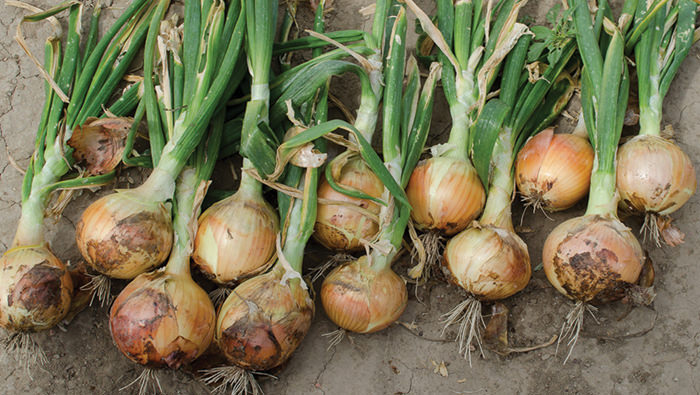
Ever wonder why the onions you find at the local farmer’s markets are so large compared to those you might grow in your home garden? Onions prefer cooler temperatures but need a long growing period, often 90 days or more. This is sometimes hard to do in the northern third of the country, so many gardeners plant onion sets (dormant, immature bulbs) in the spring rather than seed. Unfortunately, the variety choices available in onion sets are not always the best varieties to grow in your location or your soil type. Consider growing onions from seed!
Which is the best variety depends primarily on where you are located.
Onion Varieties
Short Day:
These varieties start to produce bulbs when the hours of sunlight are ‘short’: 10-12 hours per day. Southern growers, zone 7 or higher (where cold temperatures do not freeze the soil solid), plant these seeds in the fall and harvest the mature bulbs in the spring.
Long Day:
These varieties start to produce bulbs when the hours of sunlight are ‘long’: 14-16 hours per day. Northern growers, zone 6 or lower will often start these seeds inside, under lights 10-12 weeks before transplanting them into the garden. Or winter sow onion seeds in containers outside in December and January. Transplanting the seedlings into the ground in spring. Harvesting is usually in mid to late summer, when the tops fall over.
Intermediate Day:
Varieties are sometimes called ‘day-neutral’ because they can be grown in most climates (except the very far north or very far south). They will set bulbs when hours of sunlight reach 12-14 hours. These can often be started right in the garden in spring and harvested throughout the season.
Starting onion seeds under lights is similar to starting other seeds, except the lights must kept at no more than 12 hours per day. If you are interested in that, then check out the first part of ‘Successful Seed Starting’ on our website.
I’m going to focus on an alternative; winter sowing onion seed – outside, in the northern part of the country. This is done when the outside temperature consistently remains below 40°, usually any time after early December and January. The occasional January/February thaw will not affect this process. Start by choosing a variety; make sure you focus only on Long Day or Intermediate varieties in this case. Short Day varieties may not have enough time to mature before the days get too long and hot. Overwintering onions are actually short-day varieties bred to plant in the southern states in late summer/early fall.

Start by choosing a plastic container with a fitted top. I use an old ‘refrigerator’ container but you can use something as simple as a recycled produce container. Drill holes in the bottom for drainage and a few holes in the top for ventilation. Fill the container with about 2-3 inches of moist seed starting mix. Don’t use garden soil; it’s too heavy and can harbor diseases that could infect your onions once spring warms the soil. Sow the seeds by scattering them on the top of the soil. The goal it to not have the seeds touching one another, but they can be close. Cover the seed with ½” of the seed starting mix and water the entire container well. Allow it to drain and cover tightly. Find a place in your yard that will remain in the shade throughout the winter and spring.

I place mine on the north side of my raised bed wall. We have many curious garden visitors even in the winter, so I have to weigh down the container so they don’t tip it over to try and see what is inside! Don’t worry if the container becomes covered with leaves or snow during the cold winter, the seeds are dormant and are cold hardy. You shouldn’t have to water them through the winter either. As soon as the weather starts to warm in the spring, the seeds will germinate and start to grow. Remove the top and water them as needed over the next 4-8 weeks. Trim the tops to keep the seedlings at 3” tall. Don’t forget to eat your trimmings! When the soil in the garden can be worked, it’s time to transplant the onion seedlings into the garden. They should be about as thick as a candle wick or pencil lead. No need to harden off these babies, they are ready for their new home but allow the container with your seedlings to dry out for a day or two before transplanting. Gently tip the container on its side and use a fork to tease the seedlings apart. Plant each seedling about 6” apart for globe type or 3-4 together for bunching types. Since your onions have been exposed to the natural sun light cycle since germinating, the bulbs will be triggered at the right time to enlarge and be mature by the time the weather get hot. You can cut the tops for ‘green onions’ once during the early season when the tops reach 6-7” tall. If any of the greens flower, harvest that one plant then. It’s time to harvest the bulbs when the tips of the greens turn brown and the tops fall over. Dig the bulbs gently on a dry day and allow them to cure before storing.

